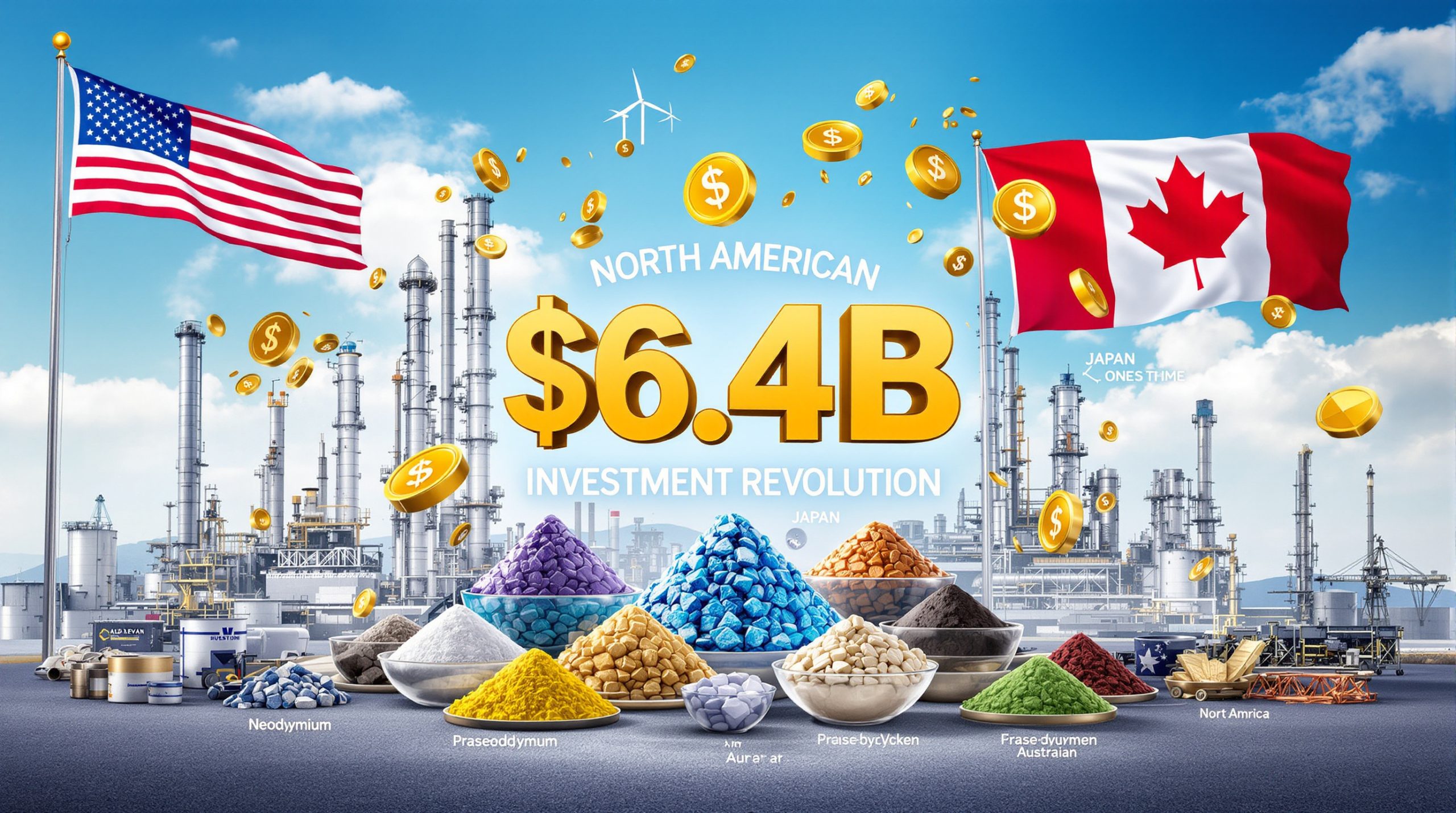Understanding the Trump-Xi Rare Earth Truce: A Limited Diplomatic Victory
The October 2024 diplomatic breakthrough between Presidents Trump and Xi Jinping has generated considerable attention in global supply chain circles. However, beneath the headlines lies a more nuanced reality: China's suspension of export controls affects only a narrow subset of rare earth elements, while the most strategically critical materials remain firmly under Beijing's oversight.
The agreement, announced by China's Ministry of Commerce on October 30, 2024, represents what industry analysts characterise as diplomatic theatre rather than substantive policy transformation. Furthermore, this Trump executive order demonstrates the complex interplay between diplomatic progress and rare earth breakthrough developments. The suspension targets secondary rare earth elements that collectively represent a small fraction of total rare earth trade value, while heavy rare earths essential for defence applications and clean energy infrastructure continue facing export restrictions.
This selective approach creates a complex landscape for American manufacturers, investors, and policymakers who must navigate between temporary diplomatic progress and persistent structural challenges in critical minerals energy access.
Elements Released from Chinese Export Controls
The Trump-Xi truce rare earths agreement specifically suspends export restrictions on five secondary rare earth elements that China had previously targeted for control. These materials include holmium for specialised laser applications, erbium for fiber optic communications infrastructure, thulium required in portable X-ray medical equipment, ytterbium essential for industrial laser systems, and europium used in LED phosphor production.
Additionally, the agreement encompasses certain lithium-ion battery inputs, though the precise specifications of these materials remain unclear from available documentation. The suspension mechanism applies only to new export controls that had been announced but never implemented, rather than rolling back existing restrictions already in effect.
Key Elements with Suspended Controls:
• Holmium – Critical for high-precision laser applications in research and manufacturing
• Erbium – Essential component in fiber optic amplifiers for telecommunications networks
• Thulium – Required for portable medical imaging equipment and radiation sources
• Ytterbium – Key material for industrial fiber laser systems
• Europium – Vital for red phosphors in LED lighting and display technologies
The strategic significance of these elements centres primarily on telecommunications infrastructure, medical equipment manufacturing, and consumer electronics production. However, their collective impact on U.S. industrial capacity remains limited compared to materials that continue facing export restrictions.
Critical Materials Still Under Chinese Control
Despite the diplomatic progress, Beijing maintains comprehensive export controls on the rare earth elements most essential for advanced manufacturing and national security applications. These restrictions preserve China's leverage over American defence contractors, electric vehicle manufacturers, and renewable energy developers who depend on these irreplaceable materials.
Heavy rare earth elements including dysprosium, terbium, gadolinium, and lutetium remain subject to the April 4, 2024 export control framework that China implemented earlier in the year. These materials are essential for high-performance permanent magnets used in wind turbine generators, electric vehicle motors, and military guidance systems.
Materials Remaining Under Full Export Controls:
| Element Category | Strategic Applications | Alternative Sources |
|---|---|---|
| Dysprosium | Wind turbine magnets, EV motors | Extremely limited |
| Terbium | Solid-state lighting, green phosphors | Minimal availability |
| Gadolinium | MRI contrast agents, neutron capture | No viable substitutes |
| Lutetium | PET scan detectors, research applications | No commercial alternatives |
Equally significant, China continues restricting exports of high-temperature neodymium-iron-boron (NdFeB) magnets and samarium-cobalt (SmCo) magnets that serve as core components in precision defence applications and next-generation electric vehicle powertrains. These finished magnet products represent the highest value-added portion of the rare earth supply chain.
The persistence of these controls demonstrates Beijing's strategic calculation that secondary rare earth elements can be released without compromising China's dominant position in materials essential for America's defence industrial base and clean energy transition goals.
Impact on American Manufacturing Capabilities
The agreement creates a two-tiered access system that provides meaningful relief for certain industrial sectors while leaving others facing continued supply chain constraints. Telecommunications companies, medical device manufacturers, and consumer electronics producers gain improved access to materials needed for their operations.
Sectors Benefiting from Improved Access:
• Fiber optic network expansion projects requiring erbium-based amplifiers
• Medical imaging equipment manufacturing using thulium-powered X-ray sources
• LED lighting production dependent on europium-based red phosphors
• Consumer electronics displays utilising rare earth phosphor technologies
However, industries critical to America's strategic competitiveness remain constrained by ongoing export restrictions. Electric vehicle manufacturers cannot access the dysprosium and terbium required for high-efficiency motor magnets that enable extended driving ranges and improved performance characteristics.
Wind energy developers face similar constraints, as offshore wind turbines require permanent magnets containing restricted heavy rare earth elements to achieve the power density necessary for economic viability. Consequently, without reliable access to these materials, renewable energy deployment timelines may face significant delays.
Industries Still Facing Supply Constraints:
• Electric vehicle production dependent on high-performance permanent magnets
• Wind energy generation requiring rare earth magnet technologies
• Defence manufacturing for precision guidance and sensor systems
• Advanced aerospace components using specialised magnetic materials
The fundamental challenge lies in rare earth processing infrastructure rather than mining capacity alone. In addition, the current industry evolution trends highlight that even if diplomatic agreements provided access to raw materials, the United States lacks the separation facilities necessary to convert mixed rare earth concentrates into individual purified elements suitable for advanced manufacturing applications.
Economic and Investment Implications
The partial nature of the Trump-Xi truce rare earths agreement creates distinct investment opportunities and risks across different segments of the rare earth supply chain. Companies focused on telecommunications infrastructure, medical devices, and consumer electronics may experience improved cost predictability and supply security in the near term.
Short-Term Market Effects:
• Price stabilisation for secondary rare earth elements through 2025
• Reduced supply chain risk premiums for affected telecommunications projects
• Improved inventory planning capabilities for medical device manufacturers
• Enhanced cost predictability for LED lighting and display technologies
Conversely, industries dependent on restricted heavy rare earth elements face continued price volatility and supply uncertainty. Electric vehicle manufacturers, wind energy developers, and defence contractors must continue managing significant geopolitical risk in their strategic planning and capital allocation decisions.
Long-Term Strategic Considerations:
Investment opportunities in domestic rare earth processing infrastructure remain compelling despite the diplomatic progress. The agreement's limited scope reinforces the business case for American companies developing separation facilities, magnet manufacturing capabilities, and recycling technologies that can reduce dependence on Chinese supply chains.
The fundamental supply challenge persists for the most strategically important materials, creating sustained investment demand for domestic processing alternatives.
Companies positioned to benefit from this dynamic include rare earth mining operations with domestic processing partnerships, magnet recycling ventures targeting end-of-life wind turbines and electric vehicles, and research organisations developing rare earth-free alternatives for critical applications.
Structural Challenges Beyond Diplomatic Agreements
The Trump-Xi truce rare earths agreement illuminates the limitations of diplomatic solutions to complex industrial challenges rooted in decades of supply chain development and technological specialisation. China's dominance in rare earth processing stems from systematic investment in separation facilities, environmental tolerance for processing waste, and integrated supply chains connecting mining operations to finished magnet production.
Processing Infrastructure Requirements:
• Separation facilities capable of isolating individual rare earth elements from mixed concentrates
• Purification systems achieving 99.9% purity standards required for advanced applications
• Magnet manufacturing plants with precision forming and magnetisation capabilities
• Recycling infrastructure to recover materials from end-of-life products
Building comparable American infrastructure requires sustained capital investment over multiple election cycles, making political consistency essential for success. Industry estimates suggest that comprehensive domestic rare earth processing capability would require 5-7 years minimum to achieve operational status, assuming consistent policy support and regulatory streamlining.
The timeline challenge means that diplomatic agreements like the Trump-Xi truce rare earths can provide temporary market stabilisation but cannot address fundamental strategic vulnerabilities in American supply chains. Until domestic processing capacity comes online, geopolitical tensions will continue creating supply disruption risks for critical manufacturing sectors.
Investment Scale Requirements
Developing complete domestic rare earth processing capability from mining through finished magnet production requires billions of dollars in coordinated investment. Single separation facilities cost hundreds of millions to construct, while magnet manufacturing plants require additional hundreds of millions plus ongoing working capital for operations.
Allied Nation Partnerships and Supply Diversification
The limitations exposed by the Trump-Xi truce rare earths underscore the importance of building diversified supply partnerships with allied nations possessing complementary rare earth resources and processing capabilities. Australia operates significant rare earth mining facilities, while Canada hosts emerging heavy rare earth development projects that could provide alternative supply sources.
Allied Resource Capabilities:
• Australia: Major light rare earth production with emerging heavy rare earth projects
• Canada: Developing heavy rare earth mines with government strategic support
• Greenland: Substantial undeveloped rare earth deposits requiring infrastructure investment
• South Africa: Existing mining operations with potential for processing expansion
Collaborative processing partnerships could distribute development costs while reducing collective dependence on Chinese supply chains. For instance, joint ventures between American and allied critical reserves companies might achieve economies of scale necessary for competitive rare earth separation and magnet manufacturing operations.
However, allied partnerships face their own challenges including regulatory coordination, technology transfer restrictions, and differing environmental standards. Building effective collaboration requires diplomatic frameworks that address these issues while maintaining security for sensitive technologies and supply chain information.
Clean Energy Transition Complications
The Trump-Xi rare earth agreement creates potential tension between America's clean energy deployment goals and resource security objectives. Rapid renewable energy scaling requires immediate access to rare earth permanent magnets for wind turbines and electric vehicle motors, yet supply chain independence demands slower, domestically-controlled development.
Wind Energy Constraints
Offshore wind projects depend heavily on permanent magnet generators containing dysprosium and terbium for achieving the power density necessary in marine environments. Without reliable access to these materials, wind energy developers may face deployment delays that conflict with renewable energy targets established by federal and state governments.
The challenge becomes particularly acute for floating wind turbine technologies that require even higher-performance magnets due to weight constraints and maintenance accessibility limitations. These next-generation systems are essential for accessing deeper water wind resources but remain dependent on restricted Chinese materials.
Electric Vehicle Manufacturing Dilemmas
Electric vehicle manufacturers face similar trade-offs between production scaling speed and supply chain security. High-efficiency permanent magnet motors enable extended driving ranges and improved performance characteristics that consumers demand, yet these systems require rare earth elements under Chinese export controls.
Alternative motor technologies exist, including induction motors and switched reluctance designs that avoid rare earth materials entirely. However, these alternatives typically sacrifice efficiency, performance, or cost-effectiveness compared to permanent magnet systems, potentially slowing electric vehicle adoption rates.
Policy Frameworks for Long-Term Resource Security
The diplomatic progress achieved through the Trump-Xi rare earth truce provides breathing room for developing comprehensive policy frameworks that address fundamental rare earth supply chain vulnerabilities. Effective solutions require coordination across multiple government agencies and sustained commitment beyond individual election cycles.
Critical Policy Priorities:
• Infrastructure Investment: Federal funding for domestic rare earth separation and processing facilities
• Research Support: Advanced materials research targeting rare earth-free alternatives for critical applications
• Regulatory Streamlining: Environmental and permitting frameworks that enable domestic rare earth processing while maintaining safety standards
• Strategic Stockpiling: Government reserves of critical rare earth materials for national security applications
The Department of Defense has initiated several programmes targeting rare earth supply chain resilience, including contracts for domestic magnet production and recycling technology development. However, these efforts remain limited in scale compared to the comprehensive infrastructure investment required for genuine supply chain independence.
Bipartisan Commitment Requirements
Successful rare earth policy requires sustained political commitment across multiple administrations, as processing facility development timelines extend beyond typical election cycles. Creating durable policy frameworks that survive political transitions becomes essential for encouraging private sector investment in domestic rare earth infrastructure.
Market Psychology and Investor Sentiment
The Trump-Xi rare earth truce demonstrates how diplomatic announcements can influence market psychology even when fundamental supply conditions remain unchanged. Initial market reactions often focus on headlines rather than detailed analysis of which materials are actually affected by policy changes.
Investor Behaviour Patterns:
Short-term trading activity frequently responds to geopolitical news without distinguishing between secondary rare earth elements and strategically critical heavy rare earths. This creates volatility opportunities for sophisticated investors who understand the technical details underlying diplomatic agreements.
Longer-term institutional investors increasingly recognise that rare earth supply chain risks require structural solutions rather than diplomatic management. This awareness drives sustained interest in companies developing domestic processing capabilities, rare earth recycling technologies, and alternative material solutions.
Risk Assessment Evolution
The agreement's limited scope reinforces investor understanding that geopolitical risk remains embedded in rare earth supply chains regardless of diplomatic progress. This recognition supports continued risk premiums for companies dependent on Chinese rare earth supplies and validates investment in supply chain diversification initiatives.
Technical Specifications and Processing Requirements
Understanding the Trump-Xi rare earth agreement requires recognising the technical complexity involved in rare earth element separation and purification. The five elements released from export controls each require specific processing techniques and equipment that differ significantly from heavy rare earth processing requirements.
Secondary Rare Earth Processing Characteristics:
• Lower separation complexity: Secondary elements typically require fewer processing steps compared to heavy rare earths
• Established technology: Separation techniques for these elements are well-understood and commercially proven
• Moderate purity requirements: Most applications can tolerate higher impurity levels than defence applications
• Existing capacity: Some non-Chinese processing capability already exists for these elements
In contrast, heavy rare earth elements like dysprosium and terbium require sophisticated separation processes that China has perfected over decades of development. These techniques involve complex solvent extraction systems, precise temperature and pH control, and multiple purification stages that achieve the 99.9% purity levels required for advanced permanent magnet applications.
The technical knowledge gap extends beyond equipment to include process optimisation, waste management, and quality control systems that ensure consistent output meeting aerospace and defence specifications. Rebuilding these capabilities outside China requires not only capital investment but also years of operational experience and continuous improvement.
Global Rare Earth Market Dynamics
The Trump-Xi agreement occurs within broader global rare earth market dynamics that extend beyond bilateral U.S.-China relations. Other major consuming nations including Japan, South Korea, and European Union members also depend heavily on Chinese rare earth supplies for their advanced manufacturing sectors. Meanwhile, analysis from Bloomberg suggests that the agreement may actually demonstrate China's continued leverage in rare earth negotiations.
International Market Structure:
| Region | Primary Applications | Supply Vulnerabilities |
|---|---|---|
| Japan | Automotive magnets, electronics | 90%+ Chinese dependence |
| South Korea | Display technologies, batteries | Limited alternative sources |
| European Union | Wind energy, automotive | Developing domestic policies |
| United States | Defence, clean energy | Strategic stockpile programmes |
This global dependence creates opportunities for coordinated policy responses that could amplify the effectiveness of American supply chain diversification efforts. Joint procurement programmes, shared research initiatives, and coordinated stockpile management could reduce per-nation costs while building collective bargaining power with suppliers.
Environmental and Regulatory Considerations
Rare earth processing involves significant environmental challenges that have contributed to China's dominance in the sector. Chinese facilities have historically operated under less stringent environmental regulations, creating cost advantages that make competition difficult for facilities in countries with stricter environmental standards.
Environmental Processing Challenges:
• Radioactive waste management: Many rare earth ores contain thorium and uranium that require specialised disposal
• Chemical waste treatment: Separation processes generate acidic and alkaline waste streams requiring neutralisation
• Water contamination prevention: Processing facilities must prevent groundwater contamination from heavy metals
• Air emission control: Dust and chemical vapour management systems add significant operational costs
American rare earth processing development must address these environmental challenges while maintaining economic competitiveness with Chinese operations. Furthermore, according to The Guardian's coverage of the diplomatic meetings, environmental considerations were largely absent from the discussions. Advanced processing technologies that minimise waste generation and environmental impact could provide long-term competitive advantages, though they require substantial upfront research and development investment.
Conclusion: Managing Expectations in Resource Diplomacy
The Trump-Xi rare earth truce represents meaningful diplomatic progress within carefully defined parameters rather than comprehensive supply chain transformation. While secondary rare earth element access provides operational relief for telecommunications and medical equipment sectors, the fundamental challenge of heavy rare earth dependence continues constraining America's strategic industries.
For manufacturing executives, investment managers, and policy leaders, the critical insight involves recognising this agreement as temporary market stabilisation rather than structural problem resolution. Industries dependent on dysprosium, terbium, and advanced permanent magnets remain subject to Chinese supply chain control despite diplomatic progress.
Strategic Implications:
The path toward genuine resource security requires sustained domestic industrial development extending far beyond any single diplomatic initiative. Building American rare earth processing capabilities from mining through magnet manufacturing demands multi-billion dollar investment, regulatory coordination, and bipartisan political commitment over multiple election cycles.
Until these structural foundations are established, diplomatic agreements can provide temporary breathing room but cannot deliver comprehensive supply chain independence. The Trump-Xi rare earth truce exemplifies both the possibilities and limitations of managing critical material dependencies through international negotiation.
Forward-Looking Considerations
Market participants should anticipate continued volatility in heavy rare earth pricing and supply availability regardless of diplomatic progress. Investment opportunities in domestic processing infrastructure, recycling technologies, and alternative material development remain compelling given persistent structural supply challenges.
The agreement ultimately underscores that technological sovereignty requires industrial capacity rather than diplomatic assurance. American resource security will depend on building comprehensive domestic rare earth capabilities rather than managing international agreements, no matter how skilfully negotiated.
Ready to Capitalise on Critical Mineral Market Opportunities?
Discovery Alert's proprietary Discovery IQ model instantly identifies significant ASX mineral discoveries, including rare earth and critical mineral breakthroughs that can drive substantial market movements. With geopolitical tensions creating ongoing supply chain volatility, subscribers gain crucial early alerts on discoveries that could reshape the critical minerals landscape. Explore Discovery Alert's historic discovery successes and begin your 30-day free trial today to position yourself ahead of the market.




